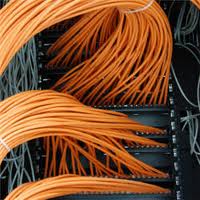Basic Structured Cabling

“Structured cabling” is a complete system of cabling and associated hardware which creates a telecommunications infrastructure. This infrastructure can serve a range of tasks, such as providing telephone service or data transmission through a computer network.
Every cabling system is unique. Variations in the structure of the facilities housing the installation, the specific cabling and connections needs, use and function, as well as customer needs requires standardization to ensure acceptable system performance from increasingly complex systems. The American National Standards Institute (ANSI) is the responsible organization for providing and maintaining standards and practices for cabling installations to ensure proper cabling installation. The benefits of these standards ensures consistency of design and installation, conformance to line requirements, standardization of documentation and a basis for assessing proposed system expansion and/or changes. structure of the facilities housing the installation, the specific cabling and connections needs, use and function, as well as customer needs requires standardization to ensure acceptable system performance from increasingly complex systems. The American National Standards Institute (ANSI) is the responsible organization for providing and maintaining standards and practices for cabling installations to ensure proper cabling installation. The benefits of these standards ensures consistency of design and installation, conformance to line requirements, standardization of documentation and a basis for assessing proposed system expansion and/or changes.
The standard term for a network installation serving a relatively small area (such as a building) is a Local Area Network, or LAN. Wide Area Networks (WAN) are networks that cover a larger geographic area than a LAN.
Structured cabling installations typically include entrance facilities housing the components providing connection to outside service facilities. The four principal types of entrance facilities include underground, tunnel, buried, and aerial.
From the entrance facility, the structured cabling network branches out to other buildings, as well as from floor to floor within a building. The term backbone is used to describe the cables handling the major network traffic. Interbuilding backbone cable handles traffic between buildings. Intrabuilding backbone cable handles traffic within in a single building.
The main components of backbone cabling are Cable pathways (shafts, conduits, and floor penetrations that provide routing space for the cables, the cables and connecting hardware and Miscellaneous support facilities.
Progressive Office Inc. has been the choice for the design and installation of business cabling infrastructure in the Washington DC area since 1986.
